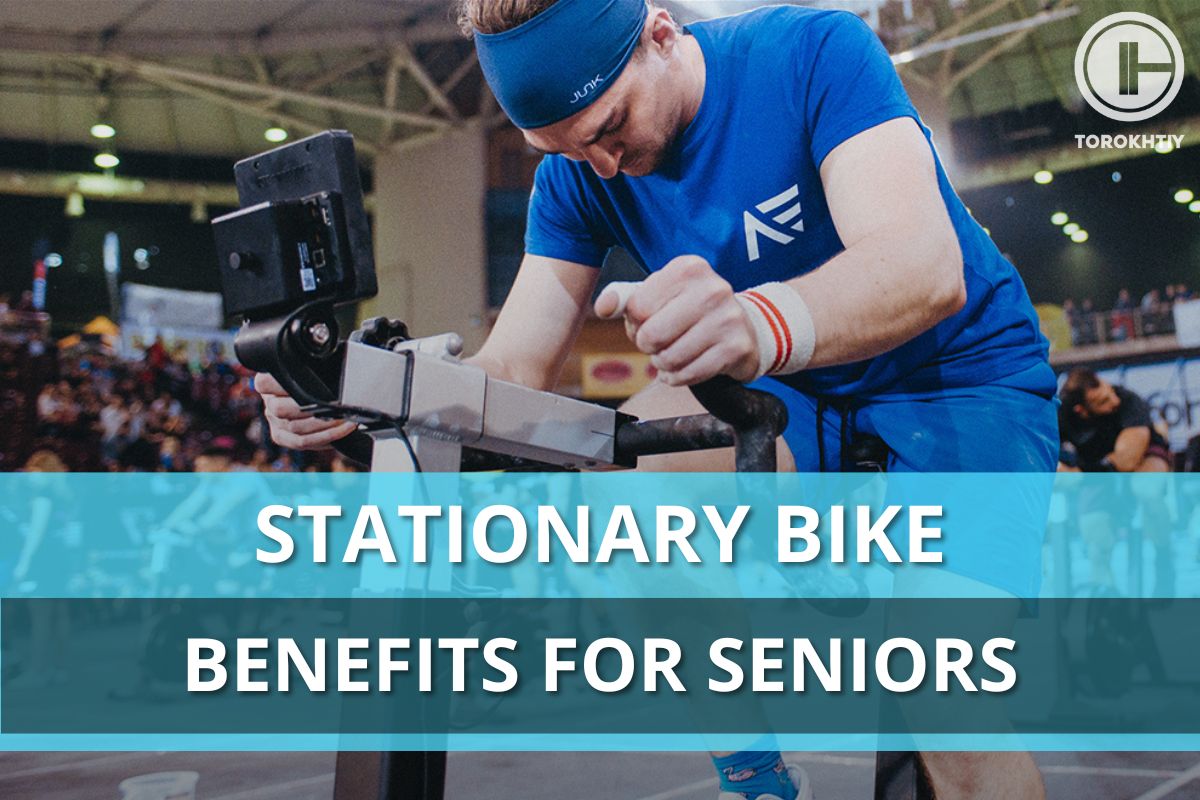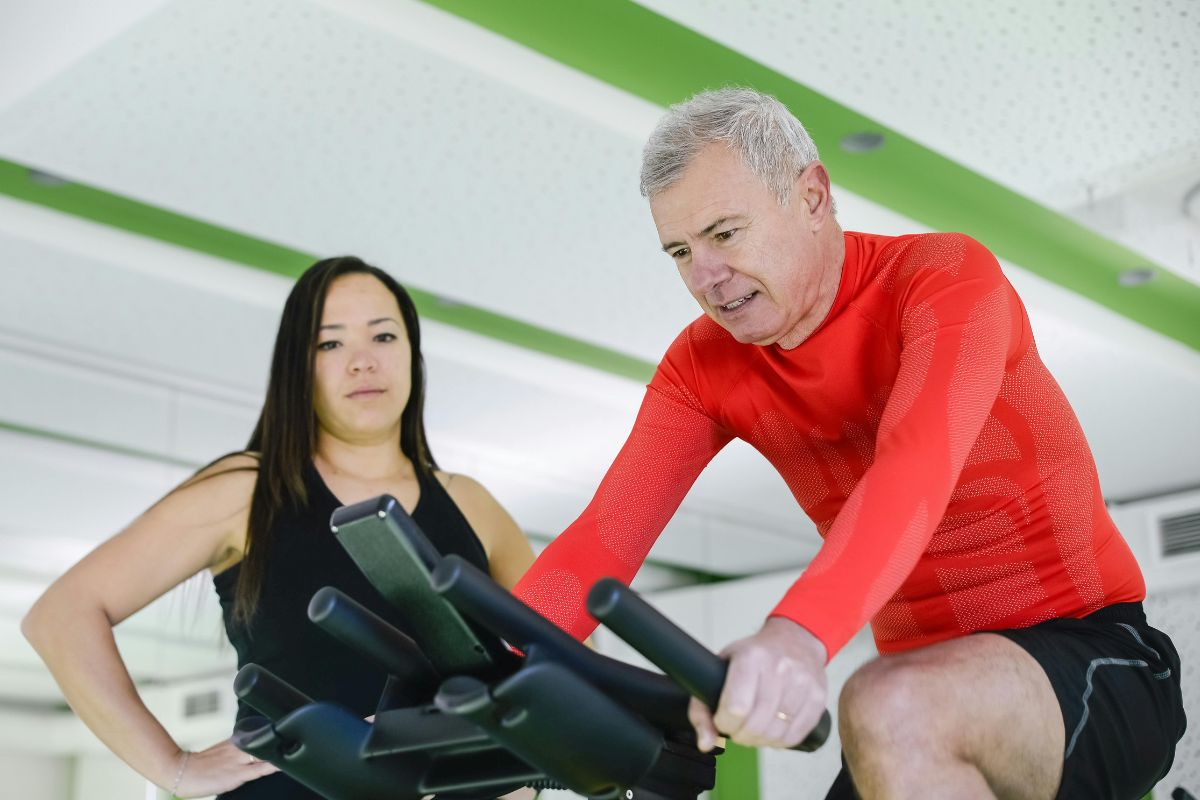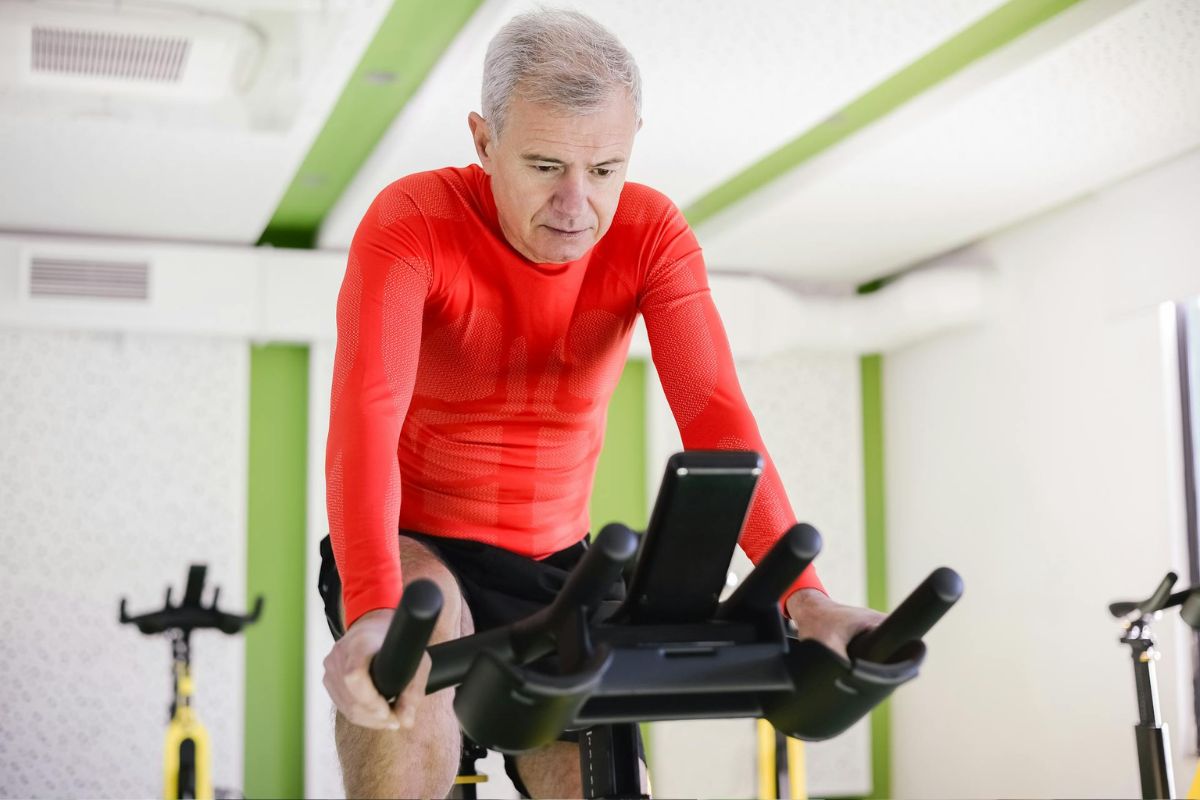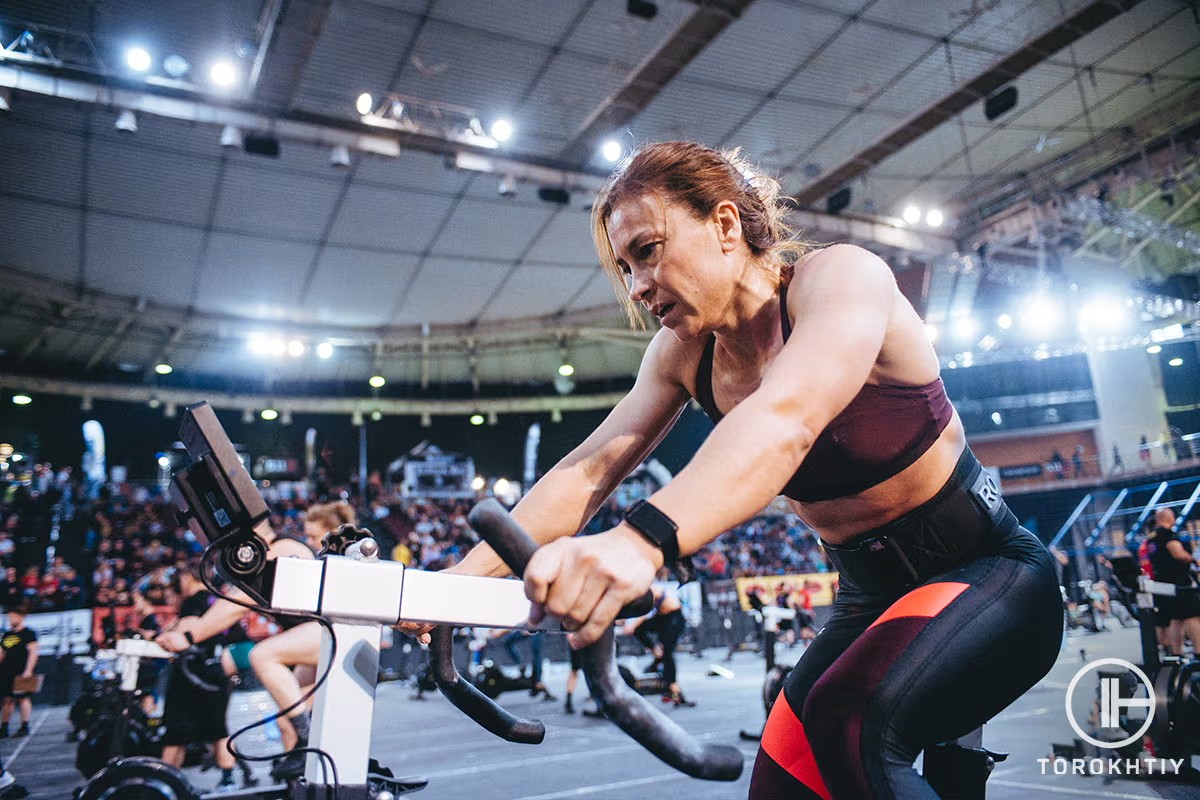Stationary Bike Benefits for Seniors
Author:
Reviewed by:
(21 years of Oly Lifting experience)
Unlock your full potential by engaging with our experts and community! Have questions about your fitness journey or looking for expert advice on weightlifting techniques? Don’t hesitate — leave a comment below and Zinaida Bondarenko will provide a personalized answer and insights to help you reach your goals.
Torokhtiy is reader-supported. Some links are affiliate links, and we may earn a commission at no extra cost to you. See our disclosure page for details.
Staying active is important regardless of age, but it becomes even more important as we age. For seniors, a regular exercise routine can mean increased mobility, better health overall and improved quality of life.
One of the best ways to stay fit without putting too much strain on the body is using a stationary bike – it’s low-impact, so it’s kind to the joints, but it still gives an exceptional cardio workout. Boosting heart health, improving endurance and balance, helping with weight management… Those are just some of the benefits.
We’ve sparked your interest? That’s great! Let’s explore everything a stationary bike can do for seniors.

What Are The Differences Between Exercise Bikes For Seniors And Others?
Exercise bikes come in various shapes and sizes, often recommended for different athletic levels. Here are some of the main differences to note between an advanced indoor bike VS the best exercise bike for elderly folk:
1. Comfort & Ergonomics
Experts highly recommend working out on a recumbent stationary bike for seniors over traditional upright position bikes. Recumbent bikes offer more comfortable and ergonomic features, including large seats, backrests, multiple sets of adjustable handlebars, and user-friendly controls.
The large chairs especially provide ample back support for seniors who traditionally struggle with it in later years. Moreover, the Arthritis Foundation recommends recumbent bikes for their joint-friendly nature.
2. User Safety
A recumbent bicycle for seniors is more accessible and safer to use than a typical indoor bicycle. Recumbent bikes have a low seat position and a step-through design, meaning older adults and people with less lower-body mobility can easily mount and dismount them without having to “climb on.”
Furthermore, these bikes have more robust and heavier frames that sit closer to the ground, making them more stable and preventing tilting or falling over during exercise.
3. Display & Control Panel
More and more exercise machines are coming equipped with high-tech touchscreen displays. That not only makes them more complicated to use but also raises their price significantly.
For seniors, we typically recommend avoiding overly complicated control panels and displays, as most of the features will go unused and are unnecessary for the average older adult exercise plan. However, we also acknowledge more tech-savvy seniors might enjoy these modern functions, so we included picks like the NordicTrack R35 as well.
3 Benefits Of Using Exercise Bikes For Seniors
Indoor cycling is among the more popular cardiovascular exercises due to its convenience and effectiveness. A stationary bicycle for seniors offers similar degrees of health benefits as a typical upright bike used by pros. Here are some noteworthy mentions:

1. Cardiovascular Health
Extensive studies on indoor cycling concluded it is effective at improving cardiovascular health, reducing blood pressure, and improving a person’s aerobic capacity and lipid profile, among other benefits.
These factors play an especially important role in the quality of life of older adults by reducing the chance of contracting or minimizing issues from common cardiovascular diseases, such as Hypertension (high blood pressure). The study also notes the importance of proper dieting and the incorporation of other physical activities to maximize results.
2. Weight Loss
According to Harvard Medical School reports, stationary cycling for 30 minutes at regular intensity burns between 210-294 calories for adults that weigh between 125-185 pounds. Numbers-wise, this puts cycling among the more impactful exercises for weight loss, only edged out by elliptical machines when performed at moderate intensity.
3. Low Impact Exercise
According to reports, one in four people suffers from chronic knee pain, often caused by arthritis (joint damage we accumulate throughout life). Osteoarthritis (OA), a type of arthritis common in knees, hips, and hands, is the most common cause of disability among the elderly. These conditions can make common exercises like lifting weights and running painful or practically impossible for seniors.
On the other hand, indoor cycling is a low-impact exercise, meaning it’s easy on the musculoskeletal system. Using a recumbent exercise bike for seniors in particular has been shown to put less exercise load on the knees, while stationary cycling proved effective at reducing pain from knee osteoarthritis.
What to Look For in the Best Exercise Bike for Seniors?
An exercise bike for your home or garage gym can be a big investment, so it’s important to get it right on your first purchase. These are the factors we considered when choosing the best stationary bike for seniors:

1. Adjustability
Adults vary not only in shape and size but also in mobility and flexibility. There is no one-size-fits-all stationary bicycle for seniors, making adjustability a crucial factor to consider before making a purchase. Thankfully, most exercise bikes offer various adjustable features, such as moveable seats, backrests, handlebar, pedals, etc.
2. Durability
The durability of your stationary bicycle for seniors varies between brands. It’s no secret that more expensive machines typically outlast more budget-friendly ones. However, it’s noteworthy that premium exercise bikes are designed for use in public gyms, where they go through a variety of users daily. With proper usage and post-workout care, any exercise bike can last for years to come.
3. Comfort
Exercise comfort is a high priority among seniors, and indoor bikes designed for them address this need by providing a host of comfort features. For instance, a typical recumbent bicycle for seniors offers a low-impact exercise thanks to a stride angle that eases the strain on the joints.
Moreover, these bikes come equipped with wide cushioned seats, backrests, ergonomic handles and pedals, and similar to ensure a comfortable and enjoyable workout.
4. Drive System
Stationary bikes come in either a front-drive or rear-drive system. The picks on this list all happen to be front-driven, as it has fewer parts and doesn’t rely on belts or chains transferring the force, making the overall exercise easier and more comfortable for seniors.
5. Assembly
The ease of assembly is a significant consideration for anyone purchasing exercise equipment, not just seniors. Manufacturers strive to minimize the required effort to set up a machine once it’s unpacked.
However, it’s essential to note that machine retailers often provide on-the-spot paid assembly, as self-assembling the equipment incorrectly may void the warranty, putting you in a tricky situation. Fortunately, a typical exercise bike for old people comes either fully assembled or mostly pre-assembled.
6. Portability
We acknowledge that seniors tend to work out at home as opposed to hitting the gym. Many people can’t designate a permanent place for their exercise bikes, especially if they live in apartments.
This is where portability features like folding and transportation wheels come in handy, helping us store away the bike when not in use. The weight of the bike is also important, as it should be light enough for a single person to move without issue.
7. Price/Quality
When picking the best stationary bike for seniors, quality for the price was arguably the most important consideration. Premium prices don’t always guarantee the best product — sometimes you’re just overpaying for brand name. Likewise, cheaper alternatives can have excellent quality for the price when you stack them up to alternatives. The top picks on this and all of our equipment ranking lists boast the best value for money.

8. User Interface
As briefly touched upon before, we valued simplicity and ease of use when judging the user interface on a typical exercise bike for older adults. However, as you get more knowledgeable about the exercise, feel free to look out for more advanced interfaces and incorporate exercise apps to take your workout to the next level. Seniors would typically prefer large displays with brighter numbers for better visibility.
NordicTrack Commercial R35 Bike
- Dimensions: 68.22 L x 23.69 W x 53.42 H inches
- Adjustable Height: Not specified
- Display: 14-inch Touchscreen
- Resistance Mechanism: Magnetic
- Product Weight: 192 lbs
- Assembly: Yes, tools and instructions included
- Maximum Weight Capacity: 350 lbs
- Best Uses For: Advanced cycling workouts
- Special Feature: Immersive display, Bluetooth media playback, iFit compatibility, AutoBreeze™ workout fan
- Warranty: 10-year frame, 2-year parts, 1-year labor
- Package: Bike, user manual, instruction tools
NordicTrack Commercial R35 Bike is a more advanced machine for tech-savvy individuals looking for a high-end exercise experience.
It has 26 levels of magnetic resistance, which can be auto-adjusted by your selected workout using the SmartAdjust™ function.
The R35 is designed for comfort. The large seat uses an ergonomic and ventilated backrest with lumbar support, as seen on premium office chairs. Easyglide™ seat adjustment lets you find the ideal seat position for your body, with strapped workout pedals ensuring your feet stay in place.
On the side of the seat, you’ll find a conveniently placed water bottle holder, as well as the important safety clip for emergency stops.
FAQ
Are Exercise Bikes Good for the Elderly?
Yes, exercise bikes are generally good for the elderly as they provide a low-impact cardiovascular workout, promote balance and stability, and can be safer for seniors compared to higher-impact exercises like running.
How Long Should a 70-Year-Old Ride a Stationary Bike?
According to the World Health Organization (WHO), adults aged 65 and above are advised to engage in 150–300 minutes of moderate-intensity aerobic activity each week.
Within this timeframe, it is recommended to have at least three exercise sessions per week that focus on activities promoting balance and stability, like exercise bikes. This has been shown to help functional capacity and reduce the risk of falls, which are common issues among older adults.
Is a Stationary Bike Better Than a Treadmill for Seniors?
Stationary bikes are often preferred by seniors for various reasons. Firstly, they exert less stress on the body as the seat provides support for the user’s weight. Secondly, they offer a safer workout experience since users remain in a seated position.
In fact, a study comparing the two exercise methods found that while both were effective, stationary cycling showed greater improvements in gait and balance for elderly women.
Conclusion
Using a stationary bike offers a lot of benefits for seniors and it’s an excellent way to stay fit and healthy. Apart from the health benefits, it’s also gentle to your joints, so it’s good for people that struggle with mobility issues or arthritis. Start with short, manageable sessions, and increase the intensity little by little to include cycling into your routine in a safe way.
As far as recommendations go, we think that the NordicTrack Commercial R35 Bike is an excellent option for people of all ages, but seniors in particular.
We’d love to hear from you as well. Are you in the market for an exercise bike? Did you know that recumbent bikes are highly recommended for older adults?
Leave a comment letting us know and remember to follow us on social media for more valuable fitness content.
Also read:
- Recumbent Bike Benefits
- Is the Stationary Bike Good Cardio
- Calories Burned on Stationary Bike
- Freebit Lit Bike Review
References:
- U.S. Department of Health & Human Services, “BMI Calculator” https://www.nhlbi.nih.gov/health/educational/lose_wt/BMI/bmicalc.htm.
- Arthritis foundation, “Best Exercise Equipment for Arthritis”.https://www.arthritis.org/health-wellness/healthy-living/physical-activity/other-activities/best-exercise-equipment-for-arthritis.
- Manuel Chavarrias, Jorge Carlos-Vivas, Daniel Collado-Mateo and Jorge Pérez-Gómez “Health Benefits of Indoor Cycling: A Systematic Review” https://www.ncbi.nlm.nih.gov/pmc/articles/PMC6722762/.
- Science Direct, Norhayati Hussein “Aerobic Capacity” https://www.sciencedirect.com/topics/nursing-and-health-professions/aerobic-capacity.
- Cleveland Clinic “Lipid Panel” https://my.clevelandclinic.org/health/diagnostics/17176-lipid-panel.
- WHO “Hypertension” https://www.who.int/news-room/fact-sheets/detail/hypertension.
- Harvard “Calories burned in 30 minutes for people of three different weights” https://www.health.harvard.edu/diet-and-weight-loss/calories-burned-in-30-minutes-for-people-of-three-different-weights (accessed March 8, 2021).
- ACL “One In Four Adults Suffers From Chronic Knee Pain” https://acl.gov/news-and-events/news/one-four-adults-suffers-chronic-knee-pain (accessed November 15, 2019).
- NIH G Peat, R McCarney, and P Croft “Knee pain and osteoarthritis in older adults: a review of community burden and current use of primary health care” https://www.ncbi.nlm.nih.gov/pmc/articles/PMC1753462/.
- Cleveland Clinic “Musculoskeletal System” https://my.clevelandclinic.org/health/articles/12254-musculoskeletal-system-normal-structure–function.
- NIH Raoul F Reiser 2nd 1, Jeffrey P Broker, Michael L Peterson “Knee loads in the standard and recumbent cycling positions” https://pubmed.ncbi.nlm.nih.gov/15133932/.
- NIH Lijiang Luan, Jaquelin Bousie, Adrian Pranata, Roger Adams, Jia Han “Stationary cycling exercise for knee osteoarthritis: A systematic review and meta-analysis” https://pubmed.ncbi.nlm.nih.gov/33167714/.
- WHO “Physical activity” https://www.who.int/news-room/fact-sheets/detail/physical-activity (accessed October 5 , 2022).
- NIH Maya Baughn, Victor Arellano, Brieanna Hawthorne-Crosby, Joseph S Lightner, Amanda Grimes, Gregory King “Physical activity, balance, and bicycling in older adults” https://pubmed.ncbi.nlm.nih.gov/36480563/.
- NIH “Effect of Stationary Cycle Exercise on Gait and Balance of Elderly Women” https://www.ncbi.nlm.nih.gov/pmc/articles/PMC3976019/.
- Photos are made by Torokhtiy Media Team, by Kampus Production from Pexels.
Why Trust Us?
With over 20 years in Olympic weightlifting, strength training, nutrition coaching, and general fitness our team does its best to provide the audience with ultimate support and meet the needs and requirements of advanced athletes and professional lifters, as well as people who strive to open new opportunities and develop their physical capabilities with us.
By trusting the recommendations of our certified experts in coaching, nutrition, and sports training programming, as well as scientific consultants, and physiotherapists, we provide you with thorough, well-considered, and scientifically proven content. All the information given in the articles concerning workout programming, separate exercises, and athletic performance, in general, is based on verified data.
The product testing process is described in more detail here.
Author: Zinaida Bondarenko
Coach, Physiotherapist
Physical rehabilitation experience: 10 years
Zinaida was a member of the national team of Ukraine in rhythmic gymnastics, accumulating 15 years of professional sports experience. She holds certifications in functional training, rehabilitation, kinesiotherapy, specializing in working with athletes across various domains: recovery, rehabilitation, functional and mobility training, General Physical Preparedness (GPP), as well as injury prevention through specific program design. Moreover, she focuses on athlete and coach education to enhance performance and prevent injuries.
Reviewed by: Oleksiy Torokhtiy
Olympic Weightlifting Champion, PhD in Sport Science
Best Results: Snatch – 200 kg,
C&J – 240 kg
Oleksiy Torokhtiy is a professional athlete boasting 20 years of experience in Olympic weightlifting. With multiple European and World titles under his belt, he has showcased his prowess in two Olympic Games (Beijing 2008 and London 2012). Upon concluding his illustrious career, Oleksiy dedicated himself to coaching. By 2022, he had conducted over 200 weightlifting seminars worldwide. He is the visionary behind an international sportswear and accessories brand known for its motto, “Warm Body Cold Mind.” Additionally, he is an esteemed author and the creator of a series of training programs and eBooks.





Still have questions after reading our article? Unlock your full potential by engaging with our experts and community! Don’t hesitate — leave a comment below and Zinaida Bondarenko will provide a personalized answer and insights to help you reach your goals.